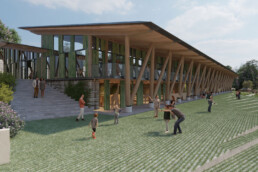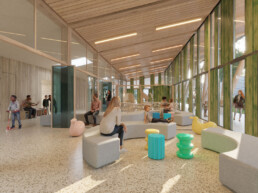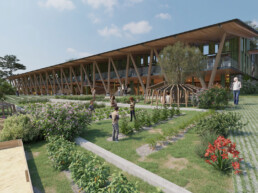Alviano (TR), Italy
Scuola Primaria ad Alviano
Year: 2022
Client: Ministero della Cultura
Area: 1.285 sqm
Status: Competition
Design: Studio Costa Architecture
CDO: A. Costa
Design Director: V. Alfonsi
Project Leader: A. Ricci
Visualizer: Opifex Laboratorio Digitale
iDEAS, CO-ENERGY, OGB STUDIO
Alviano (TR), Italy
Scuola Primaria ad Alviano
Year: 2022
Client: Ministero della Cultura
Area: 2.242 sqm
Status: Competition
Design: Studio Costa Architecture
CDO: A. Costa
Design Director: V. Alfonsi
Project Leader: A. Ricci
Visualizer: Opifex Laboratorio Digitale
iDEAS, CO-ENERGY, OGB STUDIO
A subtle balance between repetition, differentiation, and the stereometry of sculptural forms characterizes the architectural quality of the project for a new educational center for the Municipality of Alviano. The volume, with its regular layout, extends along the longer side of the intervention area and is punctuated by a series of paired and diverging ‘V’ wooden pillars supporting the double-pitched overlapping roof. The modest height and visual permeability of the wooden structures minimize the environmental-perceptual impact of the building.
The southern side overlooks the natural terrain, projecting onto the hill’s incline and defining an open and covered space below in connection with the equipped square in front. Two pathways facilitate usage: one represented by the external portico and the other internally, which, apart from its role in distribution, can be configured into various spaces through mobile structures and serve as a natural extension of multifunctional educational classrooms.
The project aims to serve as a tool and opportunity for revitalizing the Municipality of Alviano by providing a community gathering space with educational gardens, an amphitheater, and multipurpose rooms open to community activities. The overall result is a school that, in addition to fulfilling its primary function, becomes a social attraction in a network of flows and events that populate the natural slopes of the terrain, capitalizing on privileged viewpoints and forging a strong connection between the building and the landscape.
Particular attention has been paid to play spaces through the design of a school where everything that is not a classroom is a space for interaction, discussion, and integration. This follows the Design for All/Universal Design performance approach, which aims to remove not only physical barriers but also sensory-cognitive and social barriers. This approach has influenced the selection of interior and exterior furnishings, lighting fixtures, vertical connection systems, and the creation of safe spaces (relaxation/gathering areas).
The building is designed to minimize its environmental impact during construction, use, and maintenance. The roof will consist of Cross Laminated Timber panels resting on regularly spaced Glulam beams and paired pillars. The floors and infill panels will be made of Xlam, which is ideal for construction in seismic zones due to its rapid assembly and disassembly properties. It is expected that nearly all materials from demolitions will be reused, with fine aggregates used in foundation work, and stone components from demolitions reinserted into wire mesh gabion structures.
The building is oriented to maximize solar exposure and features a substantial surface covered by photovoltaic panels. A chimney ventilation system ensures constant airflow in the premises and provides natural lighting.
In terms of the systems in place, heating and ventilation rely on an underfloor radiant system, guaranteeing temperature uniformity and efficient maintenance, as well as a heat recovery system composed of two parallel heat pump systems. Rainwater recovery and electric vehicle charging points will be installed in the parking areas. The management of the systems will be centralized using a BMS (Building Management System), allowing for the adjustment of preset scenarios based on conditions detected by local sensors.



